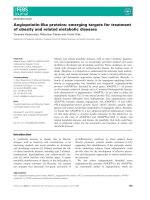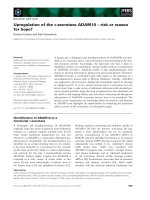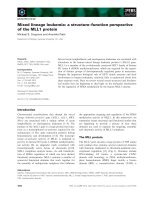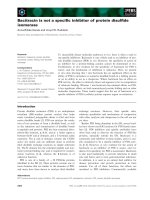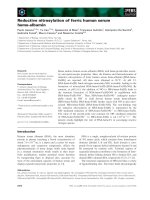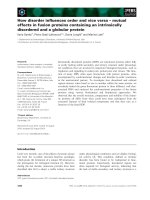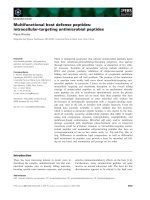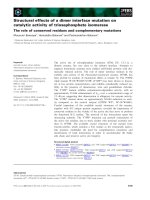Tài liệu Báo cáo khoa học: "Domain-transcending mappings in a system for metaphorical reasoning" docx
Bạn đang xem bản rút gọn của tài liệu. Xem và tải ngay bản đầy đủ của tài liệu tại đây (267.72 KB, 6 trang )
Domain-transcending mappings in a system for metaphorical reasoning
John A. Barnden, Sheila R. Glasbey, Mark G. Lee, Alan M. Wallington
School of Computer Science,
University of Birmingham,
Birmingham B15 2TT, UK.
{J.A.Barnden,S.R.Glasbey,M.G.Lee,A.M.Wallington}@cs.bham.ac.uk
Abstract
We illustrate how the use of metaphorical
views for reasoning with metaphor re-
quires the mapping of information such
as event shape, event rate and men-
tal/emotional states from the source do-
main to the target domain. Such
mappings are domain-independent and
can be implemented by means of rules we
call View Neutral Mapping Adjuncts
(VNMAs). We give a list of the main
VNMAs that appear to be required, and
show how they can be incorporated into a
pre-existing system (ATT-Meta) for
metaphorical reasoning.
1
Introduction
Lakoff (1994: p.212) gives the following exam-
ple of metaphor in a song lyric.
1) We're driving in the fast lane on the freeway
of love.
Lakoff presents this as an example of the com-
monly used conceptual metaphor (or, as we pre-
fer to call it, 'metaphorical view') LOVE AS A
JOURNEY. The progress of the love relationship
is viewed as a journey, the lovers as people un-
dertaking the journey, and the love relationship
as the vehicle in which they are travelling. In
other words, the journey is said to map to the re-
lationship's progress, the travellers to the lovers,
and the vehicle to the relationship. A metaphori-
cal view consists, in part, of such a set of map-
pings, from the "source domain" (the domain of
literal interpretation of the metaphor) to the "tar-
get domain" (the domain which is being de-
scribed by means of the metaphor). Lakoff does
not, however, explain how the excitement of the
journey is mapped over from the source domain
(i.e. the domain of vehicles and journeys) to the
target domain (the domain of the lovers and their
relationship). Yet the mapping of this emotional
state seems to be a key part of the meaning of the
metaphor, both to Lakoff and to us.
In other examples (see section 3), it is simi-
larly clear that additional aspects of the source
domain must be mapped to the target domain.
These include causation and ability, event shape,
value-judgments, uncertainty, and so on.
In order to achieve these mappings we have
designed and started to implement a set of
view
neutral mapping adjuncts
(VNMAs)
1
. We regard
VNMAs as standard but implicit default aspects
of all view-specific metaphorical mappings. They
are defaults in that they can, in principle, be over-
ridden by particular metaphorical views or by
incompatibility with the understander's knowl-
edge of the target.
Our use of VNMAs is partly inspired by Car-
bonell's (1982) proposal that certain aspects of
sources tend to map over to targets, irrespective
of the particular metaphorical view at hand. We
adopt his basic suggestion, building on it by pro-
posing a detailed and specific set of VNMAs. We
study the efficacy of these VNMAs in real-
discourse examples, and show how they can be
incorporated into the ATT-Meta system for
metaphorical reasoning (Barnden & Lee 1999),
which currently embodies some, but not much, of
this view-neutral transfer of information.
In Wallington
et al.,
(submitted) VNMAs are called
Conceptual Metaphor
Mapping Adjuncts
(COMMAS).
57
2 View-Neutral Mapping Adjuncts
The VNMAs listed here are most of those needed
for making sense of many examples that we have
examined. They fill in specific gaps in discus-
sions in the literature, and, as we show in
(Barnden 2001a, Barnden 2001b), the set copes
with a wide variety of real-discourse examples.
Although others may need to be added, the ones
so far identified are plausibly among the most
important. The final set of VNMAs needed is an
empirical matter and can only be determined over
time as we gain experience with using the tech-
nique.
Note that, in what follows, we refer to target
domain items to which source domain items are
mapped as `mappees'.
Causation/Ability
VNMA: Causation, preven-
tion, helping, ability, function/purpose and (dis)
enablement relationships between events or other
entities in the source domain map to causation,
prevention, (etc.) relationships between their
mappees (if they have any).
Change
VNMA: If there is a change event
from one state of affairs to another in the source
domain, where the states of affairs themselves
have mappees in the target domain, then the
change event has a mappee that is a change event
between the latter states of affairs.
Time-order
VNMA: The time-order of events
in a source domain is the same as that of their
mappee events, if any.
Duration
VNMA: Qualitative length of time,
in the context of the source domain, that is con-
sumed by an event maps identically to qualitative
length of time, in the context of the target do-
main, consumed by the mappee event, if any.
E.g., if something takes a long time in the context
of the source domain then its mappee takes a
long time in the context of the target. Also,
qualitative duration comparisons map over.
Rate
VNMA: Qualitative rate of progress of an
event in the source domain maps identically to
qualitative rate of progress of its mappee, if any.
E.g., if an event progresses slowly in the context
of the source domain, then its mappee progresses
slowly in the context of the target domain
2
.
Event-Shape
VNMA: Aspectual features of
events, such as whether they have a start or end,
2
We use the term 'event' very broadly in this paper.
or are intermittent, map identically to any map-
pee events.
Mental/Emotional States
VNMA: If some
agents in the source domain have mappees that
are also agents, then their mental and emotional
states map identically, provided that the objects
or propositional contents (if any) of the states can
be modified by mapping relationships that apply.
E.g., if John and Mary arguing is metaphorically
viewed as engaging in physical combat, then the
source domain proposition that John believes he
is losing in the combat maps to the target domain
proposition that
John believes he is losing the
argument
assuming that combat-losing maps to
argument-losing.
Value-Judgment
VNMA: Levels of goodness,
importance or other types of value assigned by
the understander to states of affairs in the source
domain map identically to levels of goodness,
etc., of their mappee states of affairs, if any.
Uncertainty
VNMA: The level of certainty
with which situations hold in the source maps at
least roughly to level of certainty with which
their mappee situations, if any, hold.
Modality
VNMA: Relative degree of neces-
sity, possibility, obligation, tendency, etc., in the
source domain, for actors to undertake actions or
for a state of affairs to obtain, maps identically to
relative degree of necessity, possibility, etc., in
the mappee situations, if any.
Qualitative Degree VNMA: If the holding of a
graded property or relationship in the source
maps to the holding of a graded property or rela-
tionship in the target, then the qualitative abso-
lute and relative degrees map over identically.
For example, if presence of above-normal tem-
perature maps to presence of anger, then a high
temperature maps to intense anger, and the higher
the temperature the more intense the anger.
Set-hood
VNMA: If entities of a certain type S
in the source map to entities of type T in the tar-
get, then a set of entities of type S in the source
maps to a set of entities of type T in the target.
Set-Size
VNMA: Qualitative size (relative or
absolute) of sets in the source domain maps
identically to qualitative size of mappee sets in
the target domain. E.g., if a set is large in the
terms of the source domain then its mappee set
(if any) is large in the terms of the target domain.
Physical-Size
VNMA: Qualitative physical
size (relative or absolute) of physical objects in
58
the source maps identically to qualitative physi-
cal sizes of mappee objects (if physical) in the
target.
Logical structure
VNMA: A special case of
this VNMA is negation: If a property or relation-
ship in the source has a mappee property or rela-
tionship, then non-possession of the source
property/relationship maps to non-possession of
the target property/relationship. Other logical
structures such as conjunction and disjunction are
similarly mapped.
3 Examples of VNMA use
The mental/emotional states VNMA allows the
mapping of the excitement in Lakoff' s example
(1, above) from the source to the target domain.
Since the agents in the source domain (the occu-
pants of the car) are mapped (in fact are identical
to) agents in the target domain (the lovers), the
emotion of excitement maps over identically.
The effect of VNMAs is needed for the fol-
lowing real-discourse example, quoted in (Grady
1997):
2) The house of psychoanalysis has many man-
sions, but some of Freud's followers have
not wanted to live in the main house and
have built their own annexes
We follow Grady in taking this example to rest
on the metaphorical views of ORGANIZATION
AS PHYSICAL STRUCTURE, the organizations
in question being various forms of psychoana-
lytic thought-system (or theory), and a view we
call THEORY AS HOME — whereby a body of
ideas, an artistic style, etc., that someone es-
pouses can be viewed as the person's home.
Presumably ORGANIZATION AS PHYSI-
CAL STRUCTURE maps physical containment
relationships to organizational containment rela-
tionships. In the source domain it can be inferred,
from the literal meaning of the utterance, that
psychoanalysis
(qua
house) physically contains
the main house, the annexes. Therefore, by the
containment mapping relationship, psychoanaly-
sis is being claimed in reality to contain corre-
sponding items. Because psychoanalysis is a
theory, it is inferred (defeasibly) that these items
are also theories.
The annexes have been built by various psy-
choanalysts. A source-domain inference from this
is that these sub-buildings have been caused to
exist by the psychoanalysts. Since these people
are also in the target domain, the causation-to-
exist is transferred by the Causation/Ability and
Event-Shape VNMAs to become cause-to-exist
propositions in the target domain. The mapping
in THEORY AS HOME combined with the
Event-Shape VNMA can create the target-
domain proposition that the people came to es-
pouse the theories corresponding to the sub-
buildings.
Finally, the source-domain proposition that
Freud' s followers have not wanted to adopt the
main theory is inferred by mapping of the state of
"wanting to " by means of the men-
tal/emotional states VNMA from the source do-
main proposition that some of people have not
wanted to live in the main house. The negation of
the state of "wanting to" is transferred by the
logical structure VNMA. Note that Grady (1997)
does not discuss how he would account for the
evidently necessary mappings that we account for
by means of VNMAs. This type of neglect is
widespread in the metaphor literature.
A further real-discourse example for which
VNMAs are needed is the following, quoted by
Goatly (1997):
3) general managers have cricks in their
necks from talking down to the Councils
and up to the Regions
This manifests the metaphorical view of
ORGANIZATIONAL CONTROL AS VERTI-
CAL POSITION. The managers control the
Councils and are controlled by the Regions. In
the source domain, the managers get cricks in
their necks because of their contortions. They
therefore experience physical suffering, and
hence emotional suffering. The causation and
emotional suffering map to the target by the Cau-
sation/Ability VNMA and the Mental/Emotional
States VNMA.
The following example illustrates the need for
a Qualitative Degree VNMA. Consider the clause
we have depicted in bold in the following pas-
sage, taken from Cosmopolitan (216(3), USA ed.,
March 1994):
59
4) In the far reaches of her mind, Anne knew
Kyle was haying an affair, but "to acknowl-
edge the betrayal would mean I'd have to
take a stand."
We suggest that a likely informational contri-
bution of the bold clause to the understanding of
the discourse as a whole is the following propo-
sition:
The idea that Kyle was having an affair was
something of which Anne had only a very low
degree of conscious awareness (i. e. on which
Anne had only a very low ability to mentally op-
erate in a conscious way).
We assume that there are two relevant meta-
phorical views: MIND IS PHYSICAL SPACE
and IDEAS ARE PHYSICAL OBJECTS, con-
taining the following relevant mappings:
When a person's mind is being viewed as a
physical space, an idea's being physically located
in the space corresponds to the person's being
able to operate mentally on the idea, to a very
low degree at least.
When an idea entertained by a person is being
viewed as physical object, and the person's con-
scious self is viewed as a person, then the ability
of the conscious self to physically operate on the
idea corresponds to the real person's ability to
operate in a conscious mental way on the idea.
We further assume that when a person's mind
is being viewed as a physical space, the person's
conscious self is viewed as a person physically
located in (the main part of) that space.
Thus, if the idea is physically located in the
far-reaches of the mind-space, whilst the con-
scious self of Anne is located in the main part of
the mind-space, then the conscious self will be
able to operate physically to only a very limited
degree on the idea. Physical operability implies
mental operability. However, we require the
Qualitative Degree VNMA to map the exact de-
gree of operability from the physical to the men-
tal domain.
4 Incorporation into a reasoning system
ATT-Meta (Barnden & Lee 1999) is a pre-
existing approach and implemented system for
metaphorical reasoning. The system is rule based
and carries out reasoning with uncertainty on the
content of metaphorical utterances. The system
currently embodies the VNMA for uncertainty.
This is handled within the infrastructure of the
reasoning engine. The rate and duration VNMAs
have recently been embodied in a default pro-
duction rule of the following form:
typei, typez, r
[([e: tYPet howte
A
Fe:
tYPe2 'target A
[rate(e, typei, Olsource)
4 [rate(e, type
2
, r)]tar
g
al
Here, 'type' refers to the classification of an
event, as, for example
eat (mary, bread) ,
and event rate is relative to event type as well as
the specific event. Logical forms for other
VNMAs have been developed along similar
lines. Furthermore, ATT-Meta already contains
facilities for expressing agents' beliefs, and these
will be extended to cope with mental/emotional
states more generally, and also value-judgments.
ATT-Meta implements the degree VNMA via
explicit specification in individual rules and the
negation VNMA via the inclusion of negative
versions of each rule. However, both these means
are cumbersome, and unlikely to form our final
solution.
As a reasoning-engine, ATT-Meta employs
query-directed (commonly called goal-directed)
reasoning. We believe this is important for meta-
phorical reasoning in discourse. Thus, we assume
that the text surrounding the metaphor poses a
question, which the metaphor then answers. Con-
sider again example 4 from section 3. We assume
that the reader/system is given the following
(simplified) query:
to-degree-exactly(Degree):can-consciously-mentally-
operate-on(anne, the-idea-that(having-affair(kyle))).
where D is a variable, or in other words, to what
particular degree is the affair idea consciously
entertainable by Anne. A conversion rule (simpli-
fied) will then transfer this query from the mental
to the physical domain:
IF to-degree-at-least(Degree): can-physically-operate-
on( P, J) THEN to-degree-at-least(Degree): can-con-
sciously-mentally-operate-on( P, J).
Reasoning about physical space will then proceed
as described in section 3. And, crucially, the
Qualitative Degree VNMA ensures that the value
60
the variable
Degree
is eventually instantiated
with will carry over.
5 Comparison to other approaches
Very few metaphor researchers have discussed
means for handling the mapping effects we
achieve by VNMAs, even though a few of the
effects are sometimes vaguely discussed (e.g.
transfer of value judgments). We should note that
the time-order/duration and event-shape VNMAs
are strongly related to the mapping of event
structure in (Lakoff 1994). Causation mapping is
a primary special case of the general preservation
of "higher-order" relationships in SME (Falken-
hainer
et al
1989). Since non-unary predicates
map identically in SME as described in (Falken-
hainer
et al
1989), some, though not all, of the
VNMAs might fall out of that identity-mapping.
However, what should be described as higher-
order and what as lower-order is to some extent
arbitrary. Also, it is not clear how the SME ap-
proach would get the effect of the VNMAs for
event-shape, modality, uncertainty, degrees and
value judgments. Moreover, although the SME
approach would be able to transfer mental states,
it would attempt to transfer a mental state relation
such as "A realizes B" in the source even when A
maps to a non-agent in the target. Although the
resulting conjectured relation in the target do-
main could be defeated by target knowledge, that
would be less efficient than not making the trans-
fer in the first place.
Our principle of query-directed reasoning for
metaphor understanding strongly supports the use
of VNMAs. The kind of information VNMAs
convey will form a part of the initial query, as we
demonstrated in the discussion of example 3, and
VNMA rules will be treated no differently from
any other rules in the process of backward-
chaining used in query-directed reasoning. Con-
trast this with an approach, like SME, in which
the systematic relations conveying the type of
information for which we use VNMAs are un-
covered in the source and transferred to the tar-
get.
A final reason why we use specific VNMAs is
that we wish to be conservative about what is
proposed. It is a larger claim than we wish to
make that higher-order properties or structures
in
general
are mapped over. Equally, it would be
too bold, without extensive further evidence, to
adopt a default such as one saying that any
source-domain property or relationship that
makes sense without change in the target domain
is to be mapped over identically.
Acknowledgments
The research was supported by EPSRC grant
GR/M64208.
References
Barnden, J.A. 2001a. Application of the ATT-Meta
metaphor-understanding approach to selected ex-
amples from Goatly. Technical Report CSRP-01-
01. School of Computer Science, University of
Birmingham, UK.
Barnden, J.A. 2001b. Application of the ATT-Meta
metaphor-understanding approach to various ex-
amples in the ATT-Meta project databank. Techni-
cal Report CSRP-01-02. School of Computer
Science, University of Birmingham, UK.
Barnden, J.A. & M.G. Lee. 1999. An implemented
context system that combines belief reasoning,
metaphor-based reasoning and uncertainty han-
dling. In P. Bouquet, P. Brezillon & L. Serafini
(Eds),
Lecture Notes in Artificial Intelligence,
1688, pp. 28-41. Springer.
Carbonell, J.G. 1982. Metaphor: an inescapable phe-
nomenon in natural-language comprehension. In
W. Lehnert & M. Ringle (Eds),
Strategies for Natu-
ral Language Processing,
pp. 415-434. Hillsdale,
N.J.: Lawrence Erlbaum.
Falkenhainer, B., K.D. Forbus & D. Gentner. 1989.
The Structure-Mapping Engine: algorithm and ex-
amples.
Artificial Intelligence
41(1), pp. 1-63.
Goatly, A. 1997.
The Language of Metaphors.
London
and New York: Routledge.
Grady, J.E. 1997. THEORIES ARE BUILDINGS
revisited.
Cognitive Linguistics
8(4), pp. 267-290.
Lakoff, G. 1994. What is metaphor? In J.A. Barnden
& K.J. Holyoak (Eds.),
Advances in Connectionist
and Neural Computation Theory, Vol 3: Metaphor
and Reminding, pp. 203-258. Norwood, N.J.: Ablex
Publishing Corp.
Wallington, A.M., J.A. Barnden, S.R. Glasbey &
M.G. Lee. School of Computer Science, University
of Birmingham. 2003. Metaphorical Reasoning
with an Economical Set of Mappings. Submitted to
DELTA,
published by the Pontificia Universidade
CatOlica de Silo Paulo
61
62
